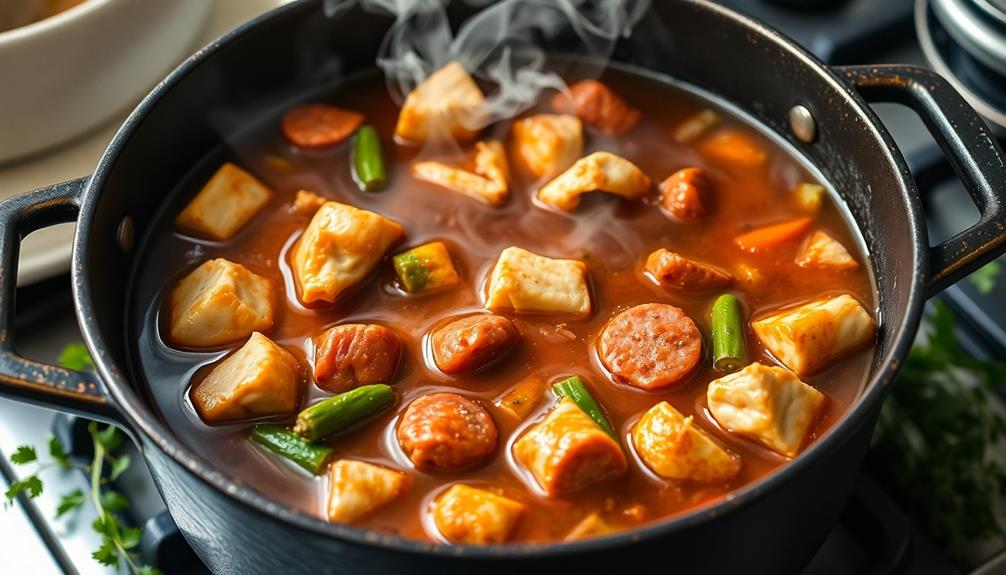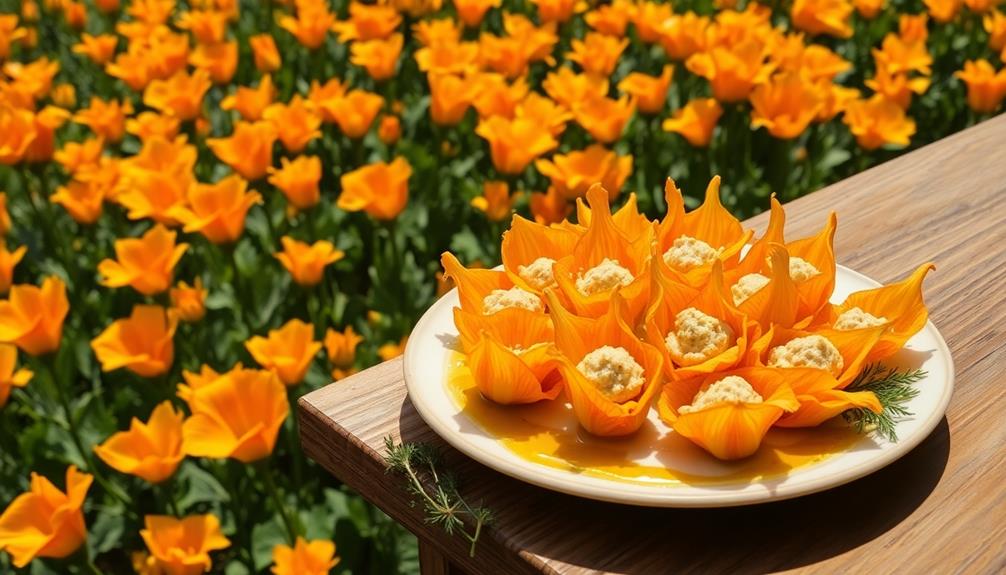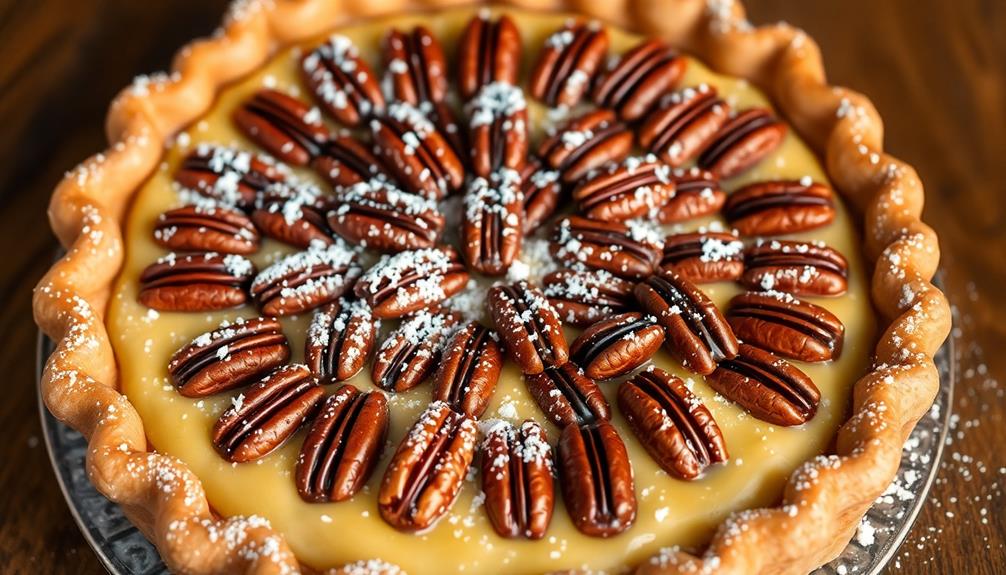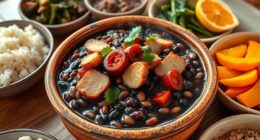Gumbo is a beloved Louisiana dish that blends a rich history and diverse cultural influences, resulting in an unparalleled depth of flavor. This classic stew features essential ingredients like andouille sausage, chicken, okra, and shrimp, all simmered in a flavorful roux-based broth. The cooking process is an art form, from carefully crafting the roux to balancing the perfect blend of spices. Gumbo symbolizes community and cultural heritage, remaining a staple in Louisiana cuisine, celebrated in festivals and local events. The dish's versatility and enduring legacy make it a culinary treasure cherished by generations – and if you keep reading, you'll discover more about this captivating Louisiana staple.
Key Takeaways
- Gumbo is a traditional Creole and Cajun dish from Louisiana, reflecting a blend of diverse cultural influences, including Indigenous, French, Spanish, and African.
- The term "gumbo" originates from the West African word for okra, a common ingredient in the dish, which is often used to thicken the stew.
- Essential ingredients in gumbo include andouille sausage, chicken, okra, and shrimp, with the roux being a crucial element that provides depth of flavor.
- Gumbo is typically served over cooked white rice, often accompanied by crusty bread or cornbread, and is known for its harmonious blend of flavors.
- Gumbo is recognized as an iconic dish that represents the culinary heritage of Louisiana, with its versatility allowing for personalization and appeal to a broad audience.
History
Gumbo's storied origins date back centuries, tracing its roots to the melting pot of cultures that converged in Louisiana. Indigenous tribes, French colonists, Spanish settlers, and enslaved Africans all left their mark on this iconic dish. The word "gumbo" itself comes from the West African word for okra, a key ingredient in many gumbo recipes.
Over time, gumbo evolved, with different regions developing their own unique variations. The Creole style, popular in New Orleans, often features tomatoes, seafood, and a roux-based broth. Cajun gumbo, from southwest Louisiana, typically has a darker roux and may include smoked meats like andouille sausage.
No matter the style, gumbo always brings people together, celebrating the diverse flavors and traditions that make Louisiana so vibrant. Today, gumbo remains a beloved staple, a tasty testament to the enduring legacy of the region's cultural melting pot.
Recipe
Gumbo is a beloved Louisiana dish that combines a rich, flavorful broth with a variety of meats, vegetables, and spices. The dish's origins can be traced back to the West African stew known as "okra soup," which was later adapted by the Creole and Cajun cultures of Louisiana. The end result is a hearty, satisfying meal that's perfect for sharing with family and friends.
Gumbo is a remarkably versatile dish, with countless regional and personal variations. While the base ingredients may remain the same, the specific proteins, vegetables, and seasonings used can vary widely. This recipe offers a classic take on the dish, but feel free to experiment and make it your own.
- 1 pound andouille sausage, sliced
- 1 pound boneless, skinless chicken thighs, cut into bite-sized pieces
- 1/2 cup all-purpose flour
- 1/2 cup vegetable oil
- 1 large onion, diced
- 1 green bell pepper, diced
- 3 celery stalks, diced
- 4 cloves garlic, minced
- 1 tablespoon Cajun or Creole seasoning
- 1 teaspoon dried thyme
- 1 teaspoon dried oregano
- 1/2 teaspoon cayenne pepper (or to taste)
- 4 cups chicken broth
- 1 (14.5-ounce) can diced tomatoes
- 1 pound shrimp, peeled and deveined
- 2 cups okra, sliced (fresh or frozen)
- Cooked white rice, for serving
In a large Dutch oven or heavy-bottomed pot, heat the oil over medium-high heat. Whisk in the flour to create a roux, and cook, stirring constantly, until the roux is a deep, mahogany color, about 15-20 minutes. Be careful not to let the roux burn.
Add the onion, bell pepper, celery, and garlic, and cook until the vegetables are softened, about 5-7 minutes. Stir in the Cajun seasoning, thyme, oregano, and cayenne pepper.
Pour in the chicken broth and diced tomatoes, and bring the mixture to a simmer. Add the sausage, chicken, shrimp, and okra, and continue to simmer, stirring occasionally, until the chicken is cooked through and the shrimp are opaque, about 20-25 minutes. Taste and adjust seasoning as needed.
Serve the gumbo over cooked white rice. Gumbo is best enjoyed with crusty bread or cornbread for dipping in the flavorful broth. The dish can be made ahead of time and reheated, and the flavors will only improve as it sits. Enjoy!
Cooking Steps
Now it's time to get cooking!
You'll start by making a rich roux – take your time and stir that mixture slowly until it's the perfect shade of brown.
Next, toss in all your veggies and let them soak up the flavors.
Then, add your protein and let it simmer away, filling your kitchen with mouthwatering aromas.
Step 1. Roux Preparation, Slow and Steady
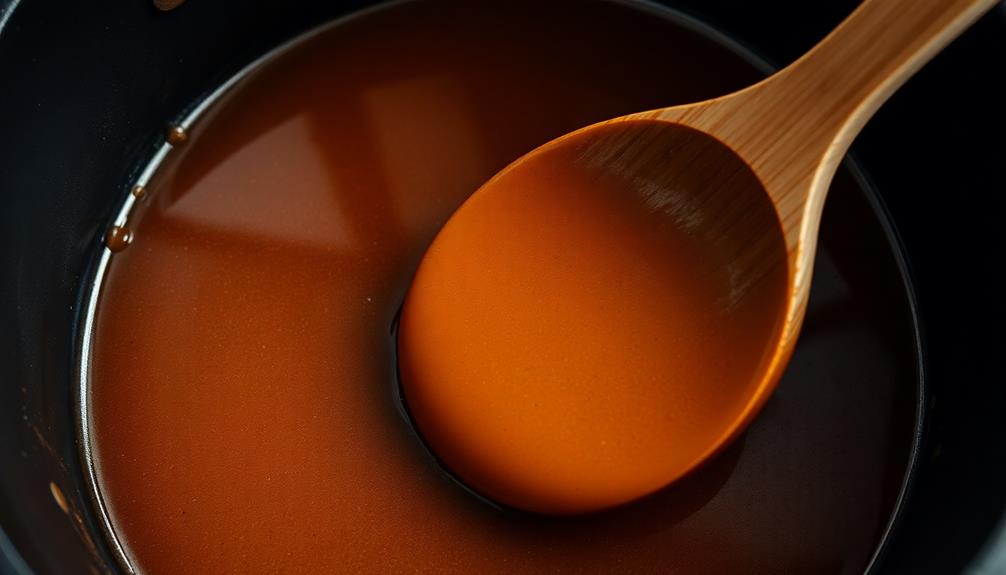
The foundation of a delectable gumbo lies in the meticulous preparation of the roux. This essential base is created by slowly cooking flour and oil together, transforming them into a rich, nutty-colored mixture.
Start by heating a heavy-bottomed pan over medium heat. Carefully add the oil and flour, stirring constantly with a wooden spoon. The key is to maintain a slow, steady pace, allowing the roux to gradually darken.
It may take 20 to 30 minutes of patient stirring, but don't rush the process. The roux needs time to develop its signature flavor and color. Keep an eye on it, adjusting the heat as needed to prevent burning.
Once the roux reaches a deep, mahogany hue, it's ready to be the foundation for your gumbo. Remember, a well-made roux is the secret to a truly exceptional dish. Take your time, and savor the rewarding aroma as it transforms before your eyes.
Step 2. Add Vegetables
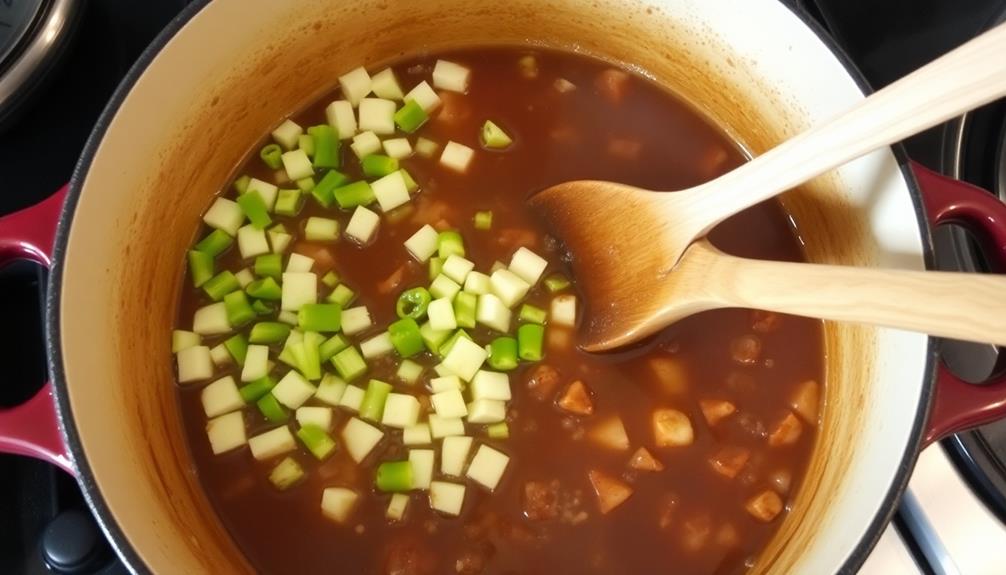
With the roux prepared, it's time to add the vegetables. Start by chopping up some onions, celery, and bell peppers. These are the holy trinity of Cajun cooking, and they'll give your gumbo an amazing flavor. Toss the chopped veggies into the pot with the roux and let them sizzle. The onions will become translucent, and the celery and peppers will soften up.
Once the veggies are tender, add some garlic. The aroma of the garlic will make your mouth water! Stir everything together, and let the flavors meld for a few minutes.
Now it's time to add the liquid. Pour in some chicken or vegetable broth, and let the gumbo simmer. The longer it cooks, the more the flavors will develop. Don't forget to season with salt, pepper, and any other spices you like. Soon, your kitchen will be filled with the irresistible scent of homemade gumbo!
Step 3. Add Meat
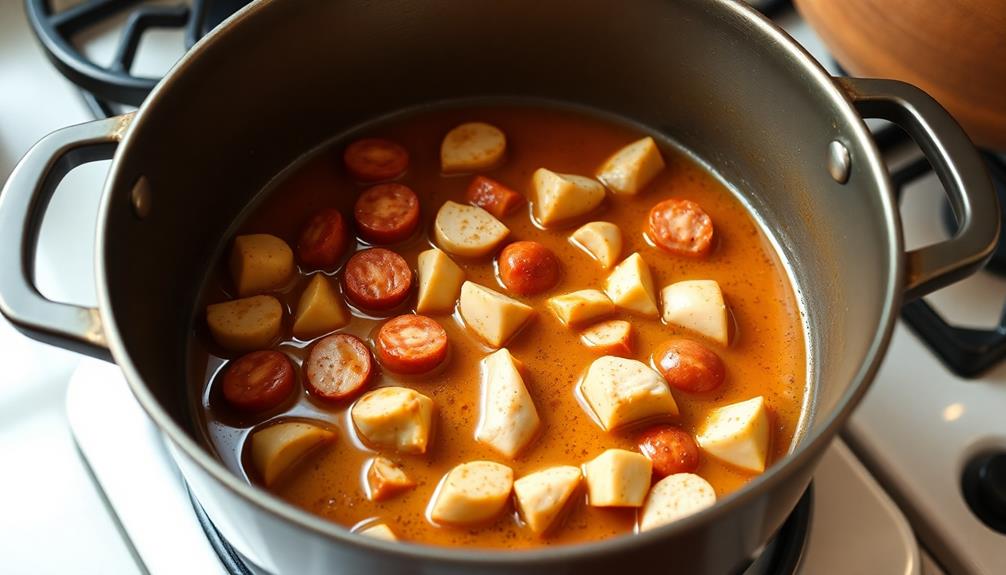
Once the aromatic vegetables have softened, it's time to add the protein. For a classic Cajun gumbo, you'll want to use a combination of meats like smoked sausage, chicken, and maybe even a little andouille.
Start by browning the sausage in the pot, getting it nice and crispy. Then, add the chicken and let it sear until it's golden brown on the outside.
Don't be afraid to really build up those flavors by letting the meats get a good char. This will add so much depth and richness to your gumbo.
Once the meats are browned, you can remove them from the pot and set them aside while you prepare the rest of the dish.
This is the perfect time to add any other proteins you might want, like shrimp or crab. Just be sure not to overcrowd the pot – you want everything to have a chance to brown and caramelize.
With the meats added, your gumbo is really starting to take shape!
Step 4. Add Stock and Simmer
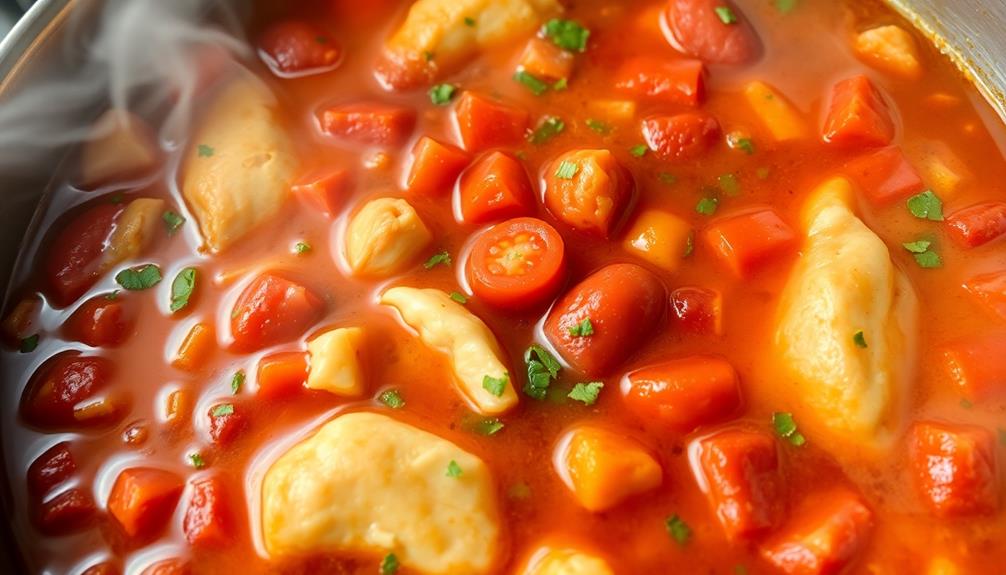
Next up, pour in the stock and bring the mixture to a gentle simmer. This step helps blend all the flavors together, creating that signature gumbo taste.
Reach for a large pot and carefully pour in the broth, whether it's chicken, vegetable, or seafood stock. Bring the liquid to a light simmer, not a rapid boil. This gentle heat allows the ingredients to meld and the flavors to develop.
Let the gumbo simmer for about 30 minutes, stirring occasionally. The long, slow cooking process tenderizes the meat and vegetables. You'll know it's ready when the broth has thickened slightly and the gumbo has a rich, velvety texture.
Be patient – the wait is worth it! Adjust the seasoning as needed, adding more salt, pepper, or spices to suit your taste. Soon, your kitchen will be filled with the mouthwatering aroma of homemade gumbo.
Get ready to ladle up big, hearty bowls.
Step 5. Add File or Season to Taste
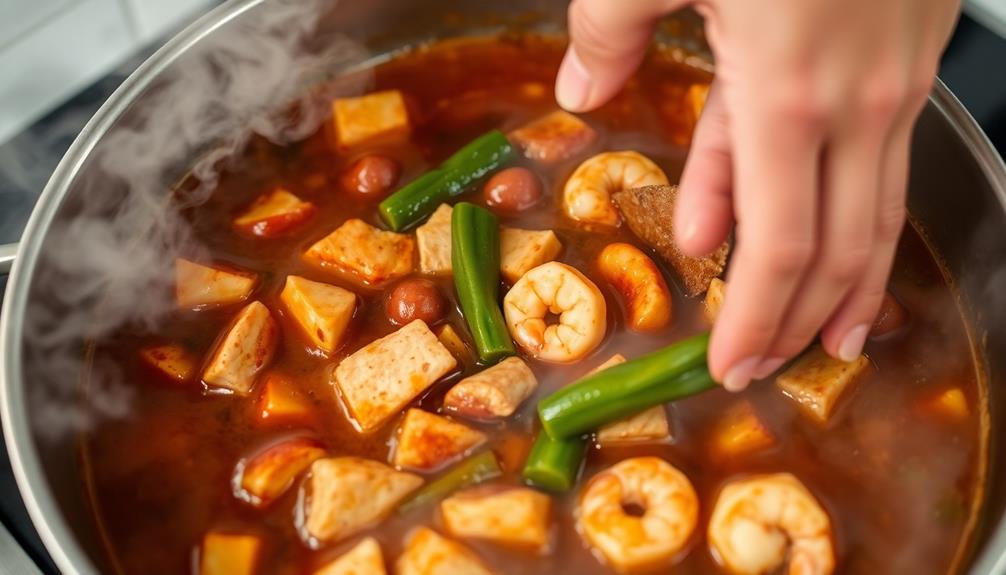
The final step in creating an authentic gumbo is to add the file powder. File is a spice made from dried and ground sassafras leaves, and it plays a crucial role in thickening and flavoring your gumbo.
Sprinkle in a bit of file, a teaspoon or two, and stir it in gently. You'll notice the gumbo becoming richer and more aromatic.
Don't be afraid to taste as you go and add more file if you'd like an even thicker consistency. You can also season with salt, pepper, and other spices to suit your personal taste.
A little goes a long way, so start with small amounts and adjust until the flavor is just right. The goal is to create a harmonious blend of all the delicious ingredients you've worked so hard to prepare.
Take your time and enjoy this final step – the rewards of your labor will soon be yours to savor!
Final Thoughts
With the flavors of Gumbo now firmly in your mind, it's time to reflect on its enduring legacy. This iconic dish has stood the test of time, captivating taste buds across generations.
Gumbo's rich history, diverse ingredients, and cultural significance make it a true culinary treasure. As you savor the final bites, you can't help but appreciate the harmonious blend of flavors that come together in each spoonful.
The combination of tender meats, fresh seafood, and aromatic vegetables creates a symphony on the palate, transporting you to the heart of Cajun and Creole cuisine.
Gumbo's versatility is part of its charm. Whether you prefer a thick, hearty stew or a lighter, more broth-based version, there's a recipe to suit every taste.
The ability to customize it with personal touches, like the addition of your favorite herbs or the perfect level of spice, makes Gumbo a truly rewarding culinary experience.
Frequently Asked Questions
What Is the Origin of the Name "Gumbo"?
You know, the name "gumbo" has a pretty interesting history!
It actually comes from the West African word "ki ngombo," which means "okra." That's right – the name refers to the key ingredient in this delicious dish. Isn't that cool? The word jambalaya itself suggests a rich and flavorful dish that is packed with tasty ingredients. And when it comes to the Cajun jambalaya recipe, it definitely lives up to that expectation. The combination of spicy andouille sausage, succulent shrimp, and tender chicken, all simmered together with rice and the holy trinity of onions, bell peppers, and celery, creates a dish that is truly a feast for the senses.
The dish itself likely originated in West Africa, but it's become a beloved staple in many cultures around the world.
Isn't it amazing how food can bring people together and connect us to different traditions?
Can Vegetarians Make Gumbo?
Absolutely! Vegetarians can absolutely make delicious gumbo. You don't need meat to enjoy this tasty stew.
Instead, you can use hearty veggies like okra, bell peppers, and tomatoes. Throw in some rice and seasonings, and you've got a flavorful, filling meal.
The great thing about gumbo is it's so versatile – you can tailor it to your dietary needs. So don't be afraid to get creative and whip up a veggie-packed gumbo that'll satisfy your cravings.
How Long Does Gumbo Keep in the Refrigerator?
Gumbo can stay fresh in the fridge for up to 3-4 days!
That's plenty of time to enjoy those delicious leftovers. Just store it in an airtight container and it'll be good as new when you're ready for another bowl.
The key is keeping it chilled – that'll help the flavors stay bold and vibrant.
Can Gumbo Be Frozen and Reheated?
Absolutely! Gumbo can definitely be frozen and reheated.
In fact, freezing is a great way to save your delicious gumbo for later. Just let it cool completely, then transfer it to an airtight container or freezer bag.
When you're ready to enjoy it again, simply thaw it in the fridge overnight and reheat it on the stovetop or in the microwave.
The flavors will still be amazing, and you can savor that hearty, comforting gumbo anytime!
Is Gumbo Gluten-Free?
Absolutely, gumbo can be gluten-free!
The key ingredients in classic gumbo – like chicken, sausage, okra, and a roux made with gluten-free flour – are all naturally gluten-free.
Just be sure to check the labels on any packaged items you use, and you're good to go.
With a little planning, you can enjoy this delicious, hearty dish without any worries about gluten.
Doesn't that sound great?
